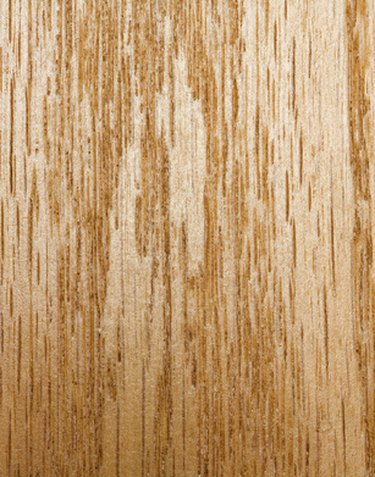
Oak is the most common of all the hardwoods. Its familiar grain pattern has become so popular that oak furniture, particularly antique furniture, is referred to as "traditional." Although there are many types of oak, two species of oak are common to the northern hemisphere. Red oak, which is the workhorse of the hardwood industry, is common, while its cousin, white oak, is more exclusive, harder, and more expensive.
Grain
Video of the Day
Red oak has a zig-zag pattern, broad-grained, that allows stain to sink into open pores, highlighting the grain even more. White oak is straighter with a tighter grain pattern. Stain will not penetrate the grain easily, making staining of white oak more consistent.
Video of the Day
Color and Odor
Red oak in its raw state has slightly pink heartwood, (the wood between the grain patterns) and will chip or splinter because of a semi-hard texture. White oak ranges from a dark gray to a whitish-gray with a glassy surface and is not prone to chipping. White oak has a distinctive perfume-like odor when cut. Red oak has a sawdust smell when cut.
Hardness
White oak is much harder and heavier than red oak. White oak ranks with maple and birch on the hardness scale. Red oak is similar to ash but harder than mahogany, cherry or walnut. For milling, red oak needs only normal hardwood saw blades, but for white oak, only the sharpest carbide-tipped blades are recommended. Grain patterns in both species are directional. If chipping or splintering is observed when milling either wood, the direction of cut should be reversed to prevent blowout and produce cleaner results.
Red Oak Precautions
Red oak in its raw form is full of tannic acid. When tannic acid mixes with water, it creates a bluish dark gray or black stain. For this reason, woodworkers must be careful when using red oak for flooring or anyplace where water can affect the wood in this manner. Red oak should be thoroughly sealed to prevent moisture from penetrating the pores.
Uses
Red oak is used widely in interior home-building for moldings, trim, cabinets and flooring. White oak is used more exclusively for fine furniture, handles, church pews, and antique reproductions. White oak's impenetrable tight grain and absence of tannic acid make it acceptable for exterior applications such as furniture and decking in boats.
Quarter-Sawn Oak
Several types of oak milling are available. The rough cut is the most common. The log is simply cut into planks; this is the most efficient way, thus the least expensive. Another cut is known as "quarter-sawn oak." This creates small flecks in the wood that reflect light. With this cut, the log is turned 1/4 turn each time it passes through the saw. It's expensive as it requires time and effort to produce and actually wastes some of the lumber in its production. You can find quarter-sawn, or "tiger-striped oak," in antiques and exclusive furniture. Or it can be specially ordered for projects.